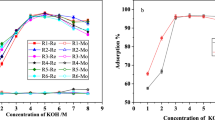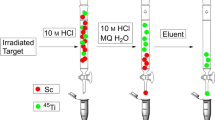Abstract
Radioactive isotope (RI) metals are a new type of tracer for positron emission tomography generated from the target metal by proton irradiation using a cyclotron. The generated metal RIs need to be separated from the target metal rapidly and effectively. In the present study, we developed a 3D-printed flow device to separate metal RIs from target metals. The separation was performed with selective formation of ethylenediaminetetraacetic acid (EDTA) complex based on the difference in formation constants. The RI metal selectively formed a EDTA complex, thus changing its ionic charge in solution. The solution was then introduced into a cation exchange column for selective adsorption of the target metal. The solution with added chelator and controlled pH was introduced into the developed system and automatically separated metal RI from target metals within 14 min. The separation method was applied to separate RI 67Ga from target metal Zn using a mixture of 107 pg L−1 67Ga in 250 mg L−1 Zn2+. The recoveries of 67Ga and Zn were 97% and 100%, respectively. Furthermore, an ultraviolet (UV) radiation reactor was integrated into the system to decompose the EDTA complex and recover the Ga3+ ion. Ga3+ recovery by UV radiation was effective, 87%. The developed system was also successfully applied to the separation of Zr and Y. Therefore, the method and system can be applied to separate other metal RIs from target metals.
Graphical abstract







Similar content being viewed by others
Data availability
All data generated or analyzed during this study are included in this published article.
References
World Health Organization (WHO), https://www.who.int/news-room/fact-sheets/detail/cancer (2022)
W. Vaalburg, P.H. Elsinga, J. Nucl. Med. 45, 695 (2004)
M. Brandt, J. Cardinale, M.L. Aulsebrook, G. Gasser, T.L. Mindt, J. Nucl. Med. 59, 1500 (2018)
Z. Tsoodol, M. Aikawa, I. Dagvadorj, T. Khishigjargal, N. Javkhlantugs, Y. Komori, H. Haba, Appl. Radiat. Isot. 159, 109095 (2020)
S. Watanabe, Y. Iida, N. Suzui, T. Katabuchi, S. Ishii, N. Kawachi, H. Hanaoka, S. Watanabe, S. Matsuhashi, K. Endo, N.S. Ishioka, J. Radioanal. Nucl. Chem. 280, 199 (2009)
H. Watanabe, A. Kawasaki, K. Sano, M. Ono, H. Saji, Bioorg. Med. Chem. 24, 3618 (2016)
M.E. Rodnick, C. Sollert, D. Stark, M. Clark, A. Katsifis, B.G. Hockley, D.C. Parr, J. Frigell, B.D. Henderson, M. Abghari-Gerst, M.R. Piert, M.J. Fulham, S. Eberl, K. Gagnon, P.J.H. Scott, EJNMMI Radiopharm. Chem. 5, 25 (2020)
J.P. Holland, Y. Sheh, J.S. Lewis, Nucl. Med. Biol. 36, 729 (2009)
Y. Sugo, R. Miyachi, S. Obata, Y. Maruyama, H. Manabe, M. Mori, N.S. Ishioka, K. Toda, S.-I. Ohira, Anal. Chem. 93, 17069 (2021)
Dojinchemical formation constants, https://www.dojindo.co.jp/technical/protocol/log.pdf.
Y. Zhang, S. Ge, J. Yu, TrAC. Trends Anal. Chem. 85, 166 (2016)
L. Wang, M. Pumera, TrAC. Trends Anal. Chem. 135, 116151 (2021)
T. Yamashita, T. Muramoto, Anal. Sci. 38, 583 (2022)
R.A. Yamashita, R.M. Carvalho, J.M. Petroni, E.R. Pedão, F.M.R. Guerbas, M.P. Tronchini, V.S. Ferreira, E.I. de Melo, R.A.B. da Silva, B.G. Lucca, Microchem. J. 182, 107853 (2022)
K.B. Anderson, S.Y. Lockwood, R.S. Martin, D.M. Spence, Anal. Chem. 85, 5622 (2013)
J.W. Engle, V. Lopez-Rodriguez, R.E. Gaspar-Carcamo, H.F. Valdovinos, M. Valle-Gonzalez, F. Trejo-Ballado, G.W. Severin, T.E. Barnhart, R.J. Nickles, M.A. Avila-Rodriguez, Appl. Radiat. Isot. 70, 1792 (2012)
Y. Zhao, S. Jiang, Y. Bai, X. Huang, B. Xiong, Anal. Sci. 37, 897 (2021)
A. Riddell, P. Kvist, D. Bernin, Rev. Sci. Instrum. 93, 084103 (2022)
R. Zhou, R. Han, M. Bingham, C. O’Rourke, A. Mills, Photochem. Photobiol. Sci. 21, 1585 (2022)
S. Waheed, J.M. Cabot, N.P. Macdonald, T. Lewis, R.M. Guijt, B. Paull, M.C. Breadmore, Lab. Chip 16, 1993 (2016)
C. Lu, S.M. Rashinkar, P.K. Dasgupta, Anal. Chem. 82, 1334 (2010)
M.A. Deri, B.M. Zeglis, L.C. Francesconi, J.S. Lewis, Nucl. Med. Biol. 40, 3 (2013)
Acknowledgements
This work was supported by JSPS KAKENHI JP 21H02870 and JP 20H03632.
Author information
Authors and Affiliations
Corresponding authors
Ethics declarations
Conflict of interest
On behalf of all authors, the corresponding author states that there is no conflict of interest.
Supplementary Information
Below is the link to the electronic supplementary material.
Rights and permissions
Springer Nature or its licensor (e.g. a society or other partner) holds exclusive rights to this article under a publishing agreement with the author(s) or other rightsholder(s); author self-archiving of the accepted manuscript version of this article is solely governed by the terms of such publishing agreement and applicable law.
About this article
Cite this article
Obata, S., Sugo, Y., Manabe, H. et al. Radioactive isotope separation with 3D-printed flow-based device. ANAL. SCI. 39, 671–677 (2023). https://doi.org/10.1007/s44211-022-00254-9
Received:
Accepted:
Published:
Issue Date:
DOI: https://doi.org/10.1007/s44211-022-00254-9




